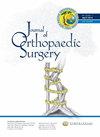Sustentaculum tali in Chinese population: anatomy and clinical significance.
IF 1.6
4区 医学
Q3 ORTHOPEDICS
引用次数: 0
Abstract
BACKGROUND Previous studies lacked adequate quantitative data on sustentaculum tali (ST), especially in Chinese population. The aims of this study are to explore the quantitative morphology of ST in dried bone specimens, and to discuss its implications related to ST screw fixation, talar articular facet variation, as well as subtalar coalitions. METHODS A total of 965 dried intact calcanei from Chinese adult donors were evaluated. All linear parameters were measured by two observers with a digital sliding vernier caliper. RESULTS Most parts of ST body can accommodate a commonly-used 4-mm-diameter screw, but the minimum height of anterior ST is only 4.02 mm. The shapes of the STs are slightly affected by left-right, subtalar facet, but the subtalar coalition may potentially increase the sizes of STs. The incidence of tarsal coalition is 14.09%. Among the osseous connection, there are 58.8% of type A articular surface and 76.5% of middle and posterior talar facet (MTF and PTF) involvement. ROC curve shows that subtalar coalition will be detected when ST length is greater than 16.815 mm. CONCLUSIONS Theoretically, all the STs can accommodate 4 mm diameter screw, but a 3.5 mm diameter screw is recommended to be placed in the middle or posterior of the small ST for safety. The shapes of the STs are greatly influenced by the subtalar coalition, while they are less affected by left-right, subtalar facet. The osseous connection is common in type A articular surface and always involved in the MTF and PTF. The cut-off value of the length of STs was confirmed as 16.815 mm for predicting subtalar coalition.中国人群的支撑骨:解剖学和临床意义。
背景:以往的研究缺乏足够的定量数据,特别是在中国人群中。本研究的目的是探讨干骨标本中ST的定量形态学,并讨论其与ST螺钉固定、距骨关节面变异以及距下联合相关的意义。方法:对965例中国成年捐献者的干的完整跟骨进行评价。所有线性参数由两个观测者用数字滑动游标卡尺测量。结果:ST椎体大部分部位可放置一枚常用的直径为4mm的螺钉,但ST前段最小高度仅为4.02 mm。左右距下关节面对STs的形状有轻微影响,但距下关节面可能会增加STs的大小。跗骨联盟发生率为14.09%。在骨性连接中,累及A型关节面占58.8%,累及距骨中、后突(MTF和PTF)占76.5%。ROC曲线显示,当ST长度大于16.815 mm时,会出现距下联合。结论:理论上,所有ST均可放置直径为4mm的螺钉,但为了安全起见,建议在小ST的中间或后部放置直径为3.5 mm的螺钉。骶髂关节的形状受距下关节联合的影响较大,而左右距下关节面对骶髂关节的影响较小。骨性连接在A型关节面很常见,并常累及MTF和PTF。STs长度的临界值为16.815 mm,用于预测距下联盟。
本文章由计算机程序翻译,如有差异,请以英文原文为准。
求助全文
约1分钟内获得全文
求助全文
来源期刊

Journal of Orthopaedic Surgery
ORTHOPEDICS-SURGERY
CiteScore
3.10
自引率
0.00%
发文量
91
审稿时长
13 weeks
期刊介绍:
Journal of Orthopaedic Surgery is an open access peer-reviewed journal publishing original reviews and research articles on all aspects of orthopaedic surgery. It is the official journal of the Asia Pacific Orthopaedic Association.
The journal welcomes and will publish materials of a diverse nature, from basic science research to clinical trials and surgical techniques. The journal encourages contributions from all parts of the world, but special emphasis is given to research of particular relevance to the Asia Pacific region.
 求助内容:
求助内容: 应助结果提醒方式:
应助结果提醒方式:


